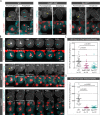Bub3-BubR1-dependent sequestration of Cdc20Fizzy at DNA breaks facilitates the correct segregation of broken chromosomes
- PMID: 26553926
- PMCID: PMC4639866
- DOI: 10.1083/jcb.201504059
Bub3-BubR1-dependent sequestration of Cdc20Fizzy at DNA breaks facilitates the correct segregation of broken chromosomes
Abstract
The presence of DNA double-strand breaks during mitosis is particularly challenging for the cell, as it produces broken chromosomes lacking a centromere. This situation can cause genomic instability resulting from improper segregation of the broken fragments into daughter cells. We recently uncovered a process by which broken chromosomes are faithfully transmitted via the BubR1-dependent tethering of the two broken chromosome ends. However, the mechanisms underlying BubR1 recruitment and function on broken chromosomes were largely unknown. We show that BubR1 requires interaction with Bub3 to localize on the broken chromosome fragments and to mediate their proper segregation. We also find that Cdc20, a cofactor of the E3 ubiquitin ligase anaphase-promoting complex/cyclosome (APC/C), accumulates on DNA breaks in a BubR1 KEN box-dependent manner. A biosensor for APC/C activity demonstrates a BubR1-dependent local inhibition of APC/C around the segregating broken chromosome. We therefore propose that the Bub3-BubR1 complex on broken DNA inhibits the APC/C locally via the sequestration of Cdc20, thus promoting proper transmission of broken chromosomes.
© 2015 Derive et al.
Figures







Similar articles
-
Role of ubiquitylation of components of mitotic checkpoint complex in their dissociation from anaphase-promoting complex/cyclosome.Proc Natl Acad Sci U S A. 2018 Feb 20;115(8):1777-1782. doi: 10.1073/pnas.1720312115. Epub 2018 Feb 5. Proc Natl Acad Sci U S A. 2018. PMID: 29432156 Free PMC article.
-
Bub1 and aurora B cooperate to maintain BubR1-mediated inhibition of APC/CCdc20.J Cell Sci. 2005 Aug 15;118(Pt 16):3639-52. doi: 10.1242/jcs.02487. Epub 2005 Jul 26. J Cell Sci. 2005. PMID: 16046481
-
SETDB2 interacts with BUBR1 to induce accurate chromosome segregation independently of its histone methyltransferase activity.FEBS Open Bio. 2024 Mar;14(3):444-454. doi: 10.1002/2211-5463.13761. Epub 2024 Jan 9. FEBS Open Bio. 2024. PMID: 38151757 Free PMC article.
-
Dual inhibition of Cdc20 by the spindle checkpoint.J Biomed Sci. 2007 Jul;14(4):475-9. doi: 10.1007/s11373-007-9157-3. Epub 2007 Mar 17. J Biomed Sci. 2007. PMID: 17370142 Review.
-
Non-mitotic functions of the Anaphase-Promoting Complex.Semin Cell Dev Biol. 2011 Aug;22(6):572-8. doi: 10.1016/j.semcdb.2011.03.010. Epub 2011 Mar 23. Semin Cell Dev Biol. 2011. PMID: 21439391 Review.
Cited by
-
A novel mutation in the N-terminal domain of Drosophila BubR1 affects the spindle assembly checkpoint function of BubR1.Biol Open. 2016 Nov 15;5(11):1674-1679. doi: 10.1242/bio.021196. Biol Open. 2016. PMID: 27742609 Free PMC article.
-
DNA Damage Responses during the Cell Cycle: Insights from Model Organisms and Beyond.Genes (Basel). 2021 Nov 25;12(12):1882. doi: 10.3390/genes12121882. Genes (Basel). 2021. PMID: 34946831 Free PMC article. Review.
-
Broken chromosomes heading into mitosis: More than one way to patch a flat tire.J Cell Biol. 2024 Apr 1;223(4):e202401085. doi: 10.1083/jcb.202401085. Epub 2024 Mar 13. J Cell Biol. 2024. PMID: 38477879 Free PMC article. Review.
-
C-Src confers resistance to mitotic stress through inhibition DMAP1/Bub3 complex formation in pancreatic cancer.Mol Cancer. 2018 Dec 15;17(1):174. doi: 10.1186/s12943-018-0919-5. Mol Cancer. 2018. PMID: 30553276 Free PMC article.
-
Myosin efflux promotes cell elongation to coordinate chromosome segregation with cell cleavage.Nat Commun. 2017 Aug 23;8(1):326. doi: 10.1038/s41467-017-00337-6. Nat Commun. 2017. PMID: 28835609 Free PMC article.
References
-
- Basu J., Bousbaa H., Logarinho E., Li Z., Williams B.C., Lopes C., Sunkel C.E., and Goldberg M.L.. 1999. Mutations in the essential spindle checkpoint gene bub1 cause chromosome missegregation and fail to block apoptosis in Drosophila. J. Cell Biol. 146:13–28. 10.1083/jcb.146.1.13 - DOI - PMC - PubMed
Publication types
MeSH terms
Substances
LinkOut - more resources
Full Text Sources
Other Literature Sources
Molecular Biology Databases
Miscellaneous

